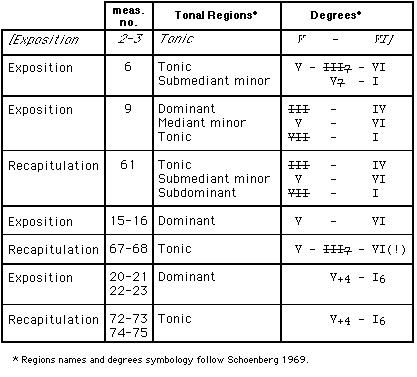

To reach homeostasis is not "a consummation to be wish'd" by a musical work. Homeostasis is a source of meaning in a negative sense. A piece of tonal music can win its meaning by struggling against homeostasis, and the end of this struggle, the reaching of homeostatic rest, signs the syntagmatic units with a death seal. What can defer death is swerve, deviation of the process toward subsidiary goals, the more distant from the destined end they are, the more they can delay accomplishment for a long time.
"Schoenberg declared that every new tone in a musical work raises a problem and demands continuation in order to restore the initial balance of the work" (Tarasti 1994: 45). Our point of view differs from Schoenberg's in that: continuation is demanded in order to avoid restoring of the initial balance, which we place even before the starting of the piece, and which is disturbed by the very first note already. The core of meaning is to be found in the resistance against the "motion toward a point of rest" (Robert Penn Warrený, quoted in Meyer 1967: 26), against resolution and release.
Our interpretation of musical works in Western tradition is based on a modeling (paradigmatic) analysis, since we try to grasp strategies of behavior through paradigmatization of homeostatic phases of tension and release in musical parameters. A consequence of the struggle for avoiding final accomplishment is that homeostatic courses have different degrees of stability (regional homeostasis) within a same parameter along the syntagmatic chain--the organization of this scale of stability being of greatest moment in the whole compositional strategy of a musical work--and, between different parameters in a same time span, the individual conducts of these courses are not coincident with each other, unless at the very end of the piece.
Kevin Korsyn speaks about the first movement of Beethoven's Sonata Op. 101 of a "rhetoric of evasions" (1983: 24): "the proportion between harmonic tension and resolution in the first movement may seem weighted in the direction of instability" (203). Robert Hatten's deep analysis of the whole work (1994: 91-111) shows in detail how reaching of a climax or resolving to a goal "might either upset the self-established propriety of the movement or too decisively break its continuity." The "thematic undercutting" is thus conveyed by evasions of authentic cadences and eludings of climax (100).
Similarly to the exposition of the Waldstein Sonata's first movement, where the second thematic area (in E major!) seems tonally preponderate over the C major of the first theme, in the first movement of Op. 101 the tonal balance is shifted toward the region of the second theme, here the dominant E major, with a striking ambiguity immediately at the beginning. The Sonata opens as if it were in E major, and the subsequent introduction of the D natural "undermines our initial interpretation of the key as E major by strongly suggesting tonal motion from tonic E major to its subdominant, A major" (Hatten 1994: 96). The character of A major as subdominant of E major, and the weakening (repression?) of the former as tonal goal is conceivable as the most important defense mechanism this Sonata puts into action in order to delay its end.
The ambiguity of key at the beginning of the Sonata needs enhancement to remain effective at the recapitulation: such effect is reached through change of mode: the development ends with a section in A minor, which makes the boundaries between development and recapitulation uncertain. Is it recapitulation already? To answer this question we should also consider the short cut the subsequent section takes in respect to the exposition. With a single touch, key and formal partition lose consistency.
Another means of opposing homeostasis here is the use of nonconclusive (mostly deceptive) cadences where tension would need to be released. A scheme could be useful to grasp the subtle variation and progression strategy employed:
